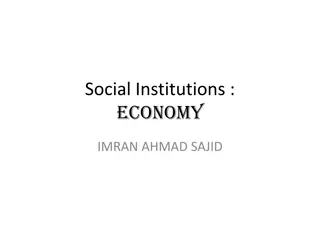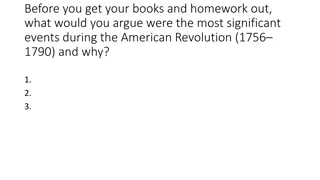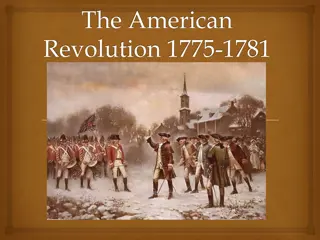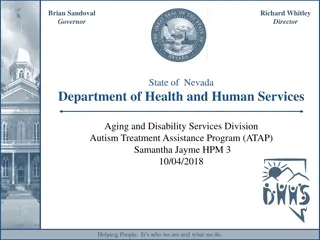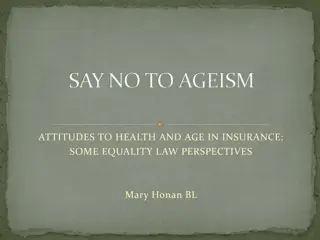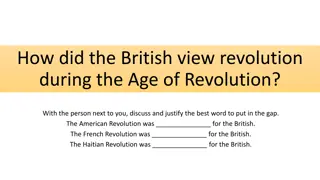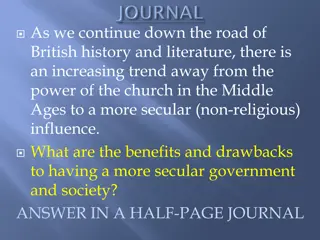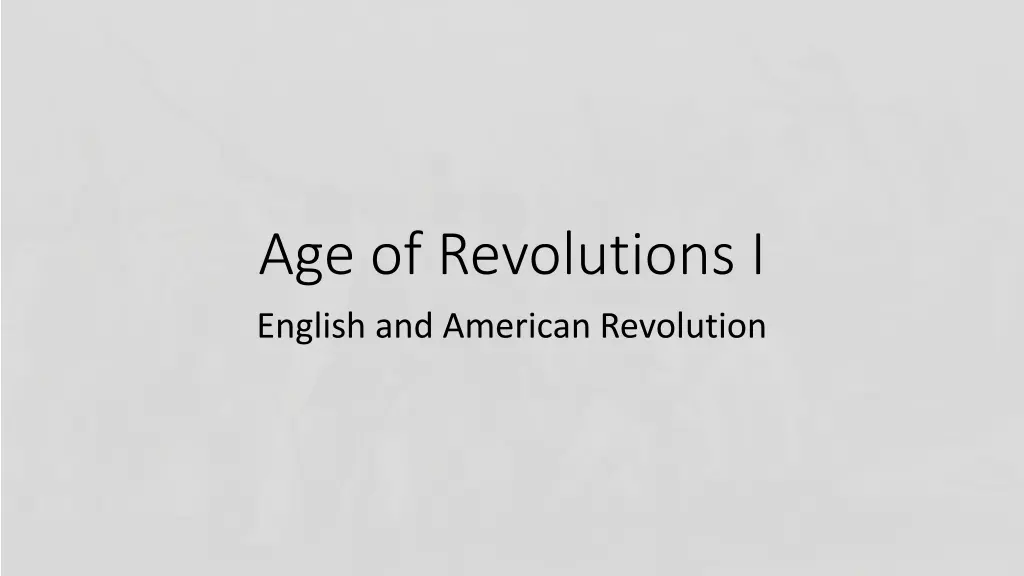
Understanding Bourgeois Revolutions: English and American Revolution Overview
Delve into the age of revolutions with a focus on the English and American revolutions. Explore the concept of bourgeois revolutions and their significance in creating a world where capitalism could flourish. Discover how these revolutions reshaped power dynamics and paved the way for new elites to emerge. Uncover key events, such as the English Revolution of 1642-1688, that laid the foundation for the modern political landscape.
Download Presentation

Please find below an Image/Link to download the presentation.
The content on the website is provided AS IS for your information and personal use only. It may not be sold, licensed, or shared on other websites without obtaining consent from the author. If you encounter any issues during the download, it is possible that the publisher has removed the file from their server.
You are allowed to download the files provided on this website for personal or commercial use, subject to the condition that they are used lawfully. All files are the property of their respective owners.
The content on the website is provided AS IS for your information and personal use only. It may not be sold, licensed, or shared on other websites without obtaining consent from the author.
E N D
Presentation Transcript
Age of Revolutions I English and American Revolution
Plan At the level of IDEAS, the age of Revolutions = marked by a general dissociation of sensibility of a previously shared worldview Politics becomes noisier and about more than only kings and courtiers, the common people begin to demand a voice! My discussion of Age of Revolutions includes: English Revolution: 1640-1688: Established Constitutional monarchy bourgeois revolution American Revolution: 1774: Bourgeois national revolution French Revolution: 1789: Bourgeois democratic revolution *Haitian Revolution: 1802; Slave led revolution; anticolonial and national Will discuss first two today, and the other two next class
What is a Bourgeois Revolution In short: Revolutions that create a world where capitalism could thrive Until the English and French revolutions in particular, European kings claimed to rule by divine right as virtually anointed by God and superior to others Shared power with (tho sometimes in conflict with) nobility (aristocracy) and clergy (Church) aka the old feudal elite The Crown, Clergy and Nobility were major landlords and thus owned the most important source of wealth viz. land Since the 11thC, and more so since the 15thC , though, LONG DISTANCE TRADE created an alternative and GROWING share of wealth Merchants and Bankers also buying land, but still EXCLUDED from power Revolutions of the 17thand 18thC created a world where these new elites could have a share of the power, at the expense of an older feudal elite
English Revolution 1642-1688 Textbook does not pay a lot of attention to the English Revolution, but it prefigured many themes of later revolutions More than a century before the French chopped off their King s head in 1793, the English had already done so in 1640 More than a century before the revolutionary wars in America, the English had fought their own bitter civil war between the supporters of a King and the supporters of Parliament More than a century before bourgeois revolutions established a new elite in power in the United States and France, a new middle class (not the nobility or clergy, nor the working class) came to in power in England, created a Constitutional Monarchy in 1688 establishing Parliamentary supremacy In most cases, certainly the English one, a plebian uprising was used and then crushed to ensure the victory of a new elite
Causes of the 1642 Revolution The Stuart kings (James I and Charles I) were firm believers in the divine right of kings; often in conflict with Parliament, upon which they depended for money Charles I even suspended Parliament for 11 years when they would not agree to his demands Compelled to recall Parliament in 1640, but relations remain strained Charles attempts to march on Parliament and arrest his critics sparks the English Civil War between Cavaliers (King s supporters) and Roundheads (Parliamentary forces)
Popular Movements and the Revolution The ENCLOSURE movement grew at this time as well, with landlords enclosing lands that had formerly been regarded as common property of villagers This prompts many small peasants to join the New Model Army (NMA), of Parliamentary forces, led by Oliver Cromwell Groups like the Levellers and Diggers put forward radical plans for redistribution of wealth and property, abolition of the Monarchy and the House of Lords and self-government through a Parliament elected every 2 years These reforms would have democratized England but threatened the privileges of members of Parliament. The movements was brutally crushed by the NMA leadership
The Commonwealth and Restoration of 1660 Charles was executed on January 30th, 1649, the first and last regicide in Britain A new Commonwealth supposedly ruled by Parliament, but in effect a dictatorship under Oliver Cromwell came into being Parliament was repeatedly dissolved and Cromwell appointed Protector An extreme puritanical regime was established where all forms of entertainment, including inns, theaters were closed, sport banned Boys caught playing football on a Sunday could be whipped as a punishment. Swearing was punished by a fine, and those who kept swearing could be sent to prison Women caught doing unnecessary work on the Holy Day could be put in the stocks. Simply going for a Sunday walk (unless it was to church) could lead to a hefty fine Cromwell s regime was not popular with the merchant and other elites who d supported him After his death, Charles II (son of the beheaded king) was invited by powerful people in England to return In 1660 monarch was restored , but a monarchy that was much closer to the model of Constitutional Monarchy, with royal powers severely curtailed
The Glorious Revolution 1688 The restored ruler Charles II, still claimed to rule by divine right and had some important sources of independent wealth (including customs revenues) Yet it was not a true restoration Restoration severely curtailed the power of the king to raise taxes, raise an army, arbitrarily arrest or imprison, among others. Most of these rights now vested in Parliament Charles II was succeeded by his brother, James II problem was the James had been brought up a Catholic The birth of a son to James raised specters of a Catholic dynasty in Britain, something unacceptable given the long history of antagonism to Catholicism But this time, rather than risk a civil war, the leaders of the British elite undertook a bloodless coup, forcing James to abdicate and inviting Charles staunchly Protestant daughter, Mary to rule, along with her husband, William III A truly constitutional monarchy, with the crown now firmly under the control of the bourgeois elite was put it place and lauded as a Glorious Revolution
Revolution in the Americas Connect with Enlightenment ideas But also specific situations on the ground These help to understand a little remembered fact the 13 colonies on the Atlantic seaboard only represented HALF of British domains in the Americas The other half, particularly the English Caribbean islands, did not revolt, planters there less settlers than sojourners, and often ABSENTEE LANDLORDS Minority status vis a vis slaves made the British redcoats a welcome not resented presence Access to British and Empire markets only through support of British government The conditions of the coastal elite along American Atlantic seaboard was different, and allowed for growth of revolutionary ideals BUT, important to note, settler elite in BOTH Caribbean and Americas thought of themselves as ENGLISH
Background to the Revolution By mid 17thC, Britain s North American colonies were prosperous, with bustling port cities A class of merchants and plantation owners dominated colonial affairs Success in the French and Indian Wars of 1750s united English colonists, emphasizing the colony s shared interests and shared identity in opposition to New France Growing Atlantic Coastal trade between the colonies, re-emphasized a new sense of shared interests particularly among coastal elites. Business and kinship cement the merchant classes of the different British colonies. Sailors form another important link Some in each colony became wealthy, and a growing gap separated the poor and the well off. In other words, class divisions became more pronounced Compared to England, there was abundance of land relative to the available labor supply. Those who could control some of that limited labor supply were the most successful in taking advantage of commercial opportunities. Status and wealth went to men who controlled the labor of other men and women, even more than to those who controlled land
More English than the English The coastal elite thought of themselves as English, modeled their cities, their institutions, their governments on those of England, sent children to English universities and to learn British law Political institutions resembled England s, mirroring the Monarch, House of Lords and House of Commons, most colonies by the 1760s were governed by; - a Royal Governor appointed by the Crown; an upper house of wealthy men appointed by the crown; and a lower house, elected by property-holding white men. Even the lower house was dominated by economic elites Colonial elites sought to mimic the English in their architecture, their social life, and their general behavior, in cities built town houses based upon architectural guide books they bought from England, and they sought to live English lives. Ironically, this Englishness was one of the reasons for the revolution The Glorious Revolution of 1688 had established primacy of Parliament, reinforced the idea that a king could no longer make law or raise taxes without Parliament s approval
Break with England Came with the British imposition of taxes after the Seven Years (aka French&Indian) War 1754-63 (one of the worlds first global wars) Because colonists paid fewer taxes than residents of England, and had gained most from the War, Parliament wanted colonists to help pay its costs Colonists developed an argument taken from their understanding of English common law, because they were not represented by English parliament, they could not be taxed, no taxation without representation Drew upon Enlightenment ideas about the sovereignty of the people, and if a government became tyrannical, it violated the social contract from which its authority came, and people had the right to overthrow such a government Objection to policy turned to opposition, and resistance became violent in 1775 when colonial militia clashed with British troops in Massachusetts, ultimately leading to war where Britain was defeated with French help
Property, Freedom, and the Revolution Colonial separatists believed republics only came into existence when independent, property-owning men participated in governing themselves, and when they retained the right and willingness to take up arms and defend their liberty in citizen militias The centrality of freedom based on property ownership is what defines and limits the American revolution Leaders of the revolution were mostly merchants, plantation owners, and lawyers: those who had formed a new sense of shared interest through the rise of an intercolonial coastal trade in previous years During the revolutionary era, the prospect of a social revolution involving women, slaves, and artisans was very real; elites labeled this the excesses of democracy Tom Paine s pamphlet Common Sense proportionally the all-time best-selling American title helped inspire support for the colonists among a wide range of classes But Paine s calls for a more inclusive democracy (that men who did not own property should still be allowed to vote and hold public office) were rejected by revolutionary leaders
Belonging and Belongings: Race and Revolution We hold these truths to be self-evident, that all men are created equal, that they are endowed by their Creator with certain unalienable Rights, that among these are Life, Liberty and the pursuit of Happiness People of African descent were about 20% of a population of around 2.5 million, almost 40% in colonies like Virginia. Most, though not all, were slaves Despite the grand prose of the Declaration of Independence, the revolutionary leadership had no intention of freeing slaves, and even Abigail Adams pointed to this contradiction, writing I have sometimes been ready to think that the passion for Liberty cannot be Eaquelly Strong in the Breasts of those who have been accustomed to deprive their fellow Creatures of theirs To John Adams, March 31, 1776 The Revolution s position on slavery was a product of a commitment to the defense of private property Slaves were seen as property and this was an important consideration even for the leaders whose own sympathies lay with abolitionism In a bid to undermine the revolutionaries Lord Dunmore, British governor of Virginia, promised outright liberty to all slaves who escaped and served the loyalist cause, more than 100,000 slaves escaped in response, 30,000 from Virginia alone Although 9,000 Black soldiers fought on the Revolutionary side, 20,000 fought for the Loyalist cause
A Gendered Revolution Women performed crucial tasks in the American Revolution, organizing fundraising drives, supplying the troops, working in the military camps, and tending to the wounded soldiers. One of the most common ways that women supported the war effort was by making homespun, home-made cloth that took on revolutionary symbolism after the colonies imposed boycotts on British goods, including textiles. Some women even acted as spies, and there is at least one documented case of a woman disguising herself as a man to fight in the war. Even as the war was on, elite women such as Abigail Adams reminded their husbands that women shared men s enthusiasm for liberty and equality and if this was ignored, women were determined to foment a Rebellion, and will not hold ourselves bound by any Laws in which we have no voice, or Representation Yet this had little impact on the republic that was eventually created. We have recently celebrated the centenary of the 19thAmendment that gave women the right to vote in 1919
Native Americans and the Revolution Native Americans were, in many respects, the unequivocal losers of the American Revolution, because one of the direct effects of the Revolution was the opening up and rapid settlement of the trans-Appalachian west Britain had made some concessions to indigenous groups, with the Proclamation of 1763 drawing a line at the Appalachians so that Indian lands to the west would be protected from European settlers That actually created support for the revolutionary cause among the colonists As late as 1775, Native Americans controlled virtually all of the land west of the Appalachians. Whites remained a distinct minority in territories west of the 1763 Proclamation line. The American Revolution obliterated that line By 1784 most of Kentucky and big chunks of western Pennsylvania and North Carolina had been seized by white settlers The following twenty years witnessed the forcible dispossession of all but the most powerful eastern Indians
Assessing the Revolution oMid 18thC, Britain stood supreme in the Atlantic world, and political revolution seemed unimaginable oThe success of the American Revolution ushered in a new age with the creation of a republican form of government that sent shock waves through the Americas and Europe and beyond oIt was one of the first political successes of the Age of Enlightenment and was to inspire many others across the world oIt also indicated a triumph of a new class of people, those who were not of noble or aristocratic descent oBut, with the treatment of women, slaves, and American Indians, it also revealed not only the possibilities but also the limits of Enlightenment thought





